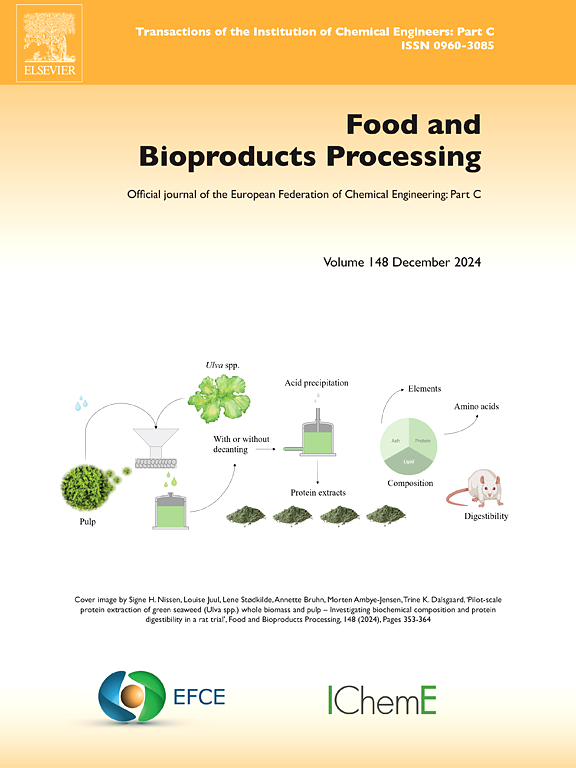Raw meat 3D laser scanning imaging: Optimized by adaptive contour unit
IF 3.5
2区 农林科学
Q2 BIOTECHNOLOGY & APPLIED MICROBIOLOGY
引用次数: 0
Abstract
In the field of intelligent meat processing, the application of 3D laser scanning technology for identifying meat contours is essential for the accurate estimation of meat volume and quantitative slicing. In this study, based on 3D laser scanning technology, a contour adaptive shaping unit was developed to address the issue of scanning irregular meat contours and improve the scanning range and volume estimation accuracy. Moreover, we developed software for contour visualization imaging and volume estimation of raw meat using Halcon and Visual C# to optimize the scanning imaging and volume estimation of pork belly, hind shank, and pork loin. The results showed that the optimal shaping angles for chilled and frozen pork (loin, hind shank, and belly) were 60°, 30°, and 30°, respectively, with a scanning accuracy of ≥ 90 % and an average increase of 3 %. After shaping, the volume forms of the three types of raw meat remained stable for 12, 9, and 6 s in the chilled and frozen state. The corresponding coefficients of variation (CV) of imaging accuracy were 0.77 %, 1.16 %, and 0.54 %, respectively, with high stability and consistency of the imaging accuracy. In addition, the pork color and the transfer speed did not significantly affect the imaging performance of the adaptive shaping system (p > 0.05). The results demonstrated that the adaptive contour shaping system exhibited superior optimization capabilities in raw meat imaging, which provided the technical basis for the subsequent research and development pertaining to adaptive quantitative slicing devices for raw meat of various specifications.
生肉三维激光扫描成像:采用自适应轮廓单元优化
在肉类智能加工领域,应用三维激光扫描技术识别肉类轮廓是准确估计肉类体积和定量切片的关键。本研究基于三维激光扫描技术,开发了一种轮廓自适应整形单元,解决了不规则肉类轮廓的扫描问题,提高了扫描范围和体积估计精度。此外,我们利用Halcon和Visual c#开发了生肉轮廓可视化成像和体积估计软件,对五花肉、后小腿和猪里脊的扫描成像和体积估计进行优化。结果表明,冷冻猪肉(里脊、后小腿和腹部)的最佳整形角分别为60°、30°和30°,扫描精度≥ 90 %,平均提高3 %。成型后,三种生肉在冷藏和冷冻状态下的体积形态在12、9和6 s内保持稳定。相应的成像精度变异系数(CV)分别为0.77 %、1.16 %和0.54 %,成像精度具有较高的稳定性和一致性。此外,猪肉颜色和传递速度对自适应整形系统的成像性能没有显著影响(p >; 0.05)。结果表明,自适应轮廓成形系统在生肉成像中表现出优越的优化能力,为后续各种规格生肉自适应定量切片装置的研发提供了技术基础。
本文章由计算机程序翻译,如有差异,请以英文原文为准。
求助全文
约1分钟内获得全文
求助全文
来源期刊

Food and Bioproducts Processing
工程技术-工程:化工
CiteScore
9.70
自引率
4.30%
发文量
115
审稿时长
24 days
期刊介绍:
Official Journal of the European Federation of Chemical Engineering:
Part C
FBP aims to be the principal international journal for publication of high quality, original papers in the branches of engineering and science dedicated to the safe processing of biological products. It is the only journal to exploit the synergy between biotechnology, bioprocessing and food engineering.
Papers showing how research results can be used in engineering design, and accounts of experimental or theoretical research work bringing new perspectives to established principles, highlighting unsolved problems or indicating directions for future research, are particularly welcome. Contributions that deal with new developments in equipment or processes and that can be given quantitative expression are encouraged. The journal is especially interested in papers that extend the boundaries of food and bioproducts processing.
The journal has a strong emphasis on the interface between engineering and food or bioproducts. Papers that are not likely to be published are those:
• Primarily concerned with food formulation
• That use experimental design techniques to obtain response surfaces but gain little insight from them
• That are empirical and ignore established mechanistic models, e.g., empirical drying curves
• That are primarily concerned about sensory evaluation and colour
• Concern the extraction, encapsulation and/or antioxidant activity of a specific biological material without providing insight that could be applied to a similar but different material,
• Containing only chemical analyses of biological materials.
 求助内容:
求助内容: 应助结果提醒方式:
应助结果提醒方式:


